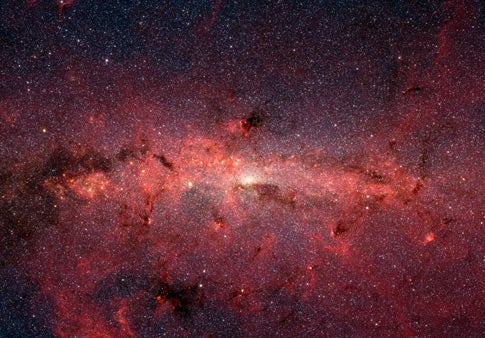Astronomers at UCLA and the University of St. Andrews, Scotland have completed the largest survey to date of stellar speeds in the Galactic bulge. The results were presented in two reports by R. Michael Rich and David Reitzel at the American Astronomical Society meeting in Seattle, Washington.
Using the 4m (159-inch) Telescope at the National Science Foundation’s Cerro Tololo Inter-American Observatory, Chile, and the Hydra spectrograph, they measured the speeds of nearly 3,000 stars, covering a swath in the bulge some 1,500 light years from the Galactic Center. The Galactic bulge, some 25,000 light years from the sun, is one of the oldest parts of the galaxy, yet it contains stars nearly as rich in metals as the Sun. Recent studies suggest that the bulge formed relatively quickly and was one of the first parts of the Galaxy to form. The bulge contains roughly 20 billion suns of material. The speeds of the stars were measured using the Doppler shift, determined from absorption lines in the spectrum.
“While the central bulge appears to us as a flattened ball, it is actually more football shaped, with the long end pointing nearly in our direction. Viewed from above the Milky Way, the bulge would be observed to rotate, looking like a football spinning end over end,” said UCLA Astronomer Michael Rich.
“The bulge has the shape it does because its stars follow orbits around the center of the Milky Way. Some of these orbits are familiar circles, like the planets of our solar systems, but others follow strange loops or long ellipses. Collectively, we can model their behavior on a computer and reproduce the bulge’s observed shape and rotation, but built from stars whose motions follow the laws of gravity,” said HongSheng Zhao, Associate Professor at the University of St. Andrews, Scotland. Zhao’s model, technically called a rapidly rotating self-consistent bar, was a technical breakthrough at the time of its development in 1996; observations have now caught up to the point of thoroughly testing it.
The new data cannot be fit by these computer models; for example, Zhao’s model predicts that the bulge rotates more rapidly than is observed. If the computer models can be forced to fit the new data, we may gain new insight into why the bulge is football shaped, and perhaps, how the bulge formed.
“A better knowledge of the orbits of bulge stars may help to predict how many stars might interact or fall into the central black hole of the Milky Way; the spectacular explosion associated with that event, a capture flare, has been observed to occur in other galaxies,” Rich said. Rich is also a member of the Galaxy Evolution Explorer science team; that satellite recently observed such a capture flare in a distant galaxy.
Stars in some parts of the bulge appear to move at nearly the same speed, apparently clustered. This is a surprising result. These clumps of stars may be the fossil remnants of star clusters or dwarf galaxies that fell into the bulge and are in the process of dissolving, or they may have an entirely different cause, perhaps linked to the bulge’s structure.
One such dissolving system, the Sagittarius dwarf spheroidal galaxy, was discovered in 1994. If the team had found stars associated with the Sagittarius dwarf galaxy, they would have appeared at a different speed from the peaks that are observed. Additional studies will be needed to determine whether the cold peaks are the ghosts of dissolving galaxies, remnants of the bulge’s formation, dying star clusters, or simply chance associations.
“At this point, we are 95% certain that these odd clumps of stars correspond to some kind of real association, but more observations will be needed to establish their nature and origin,” said UCLA Postdoctoral Scientist David Reitzel, who is leading that aspect of the investigation.
The survey was conducted rapidly, in only eight nights of observing time over the last two years. The stars were selected using the National Aeronautics and Space Administration’s Two Micron All-Sky Survey. Observations in the bulge are difficult because interstellar dust obscures much of the bulge in visible light. However, the stars were identified from infrared light that easily penetrates the dust, and their speeds measured using very red visible light. The Hydra spectrograph can observe 100 of these stars simultaneously using optical fibers. Crucial to the results are new techniques for high precision velocity measurements, developed by UCLA graduate student Christian Howard. Prior surveys were generally 5-10 times less precise and would have missed the velocity clumping.










